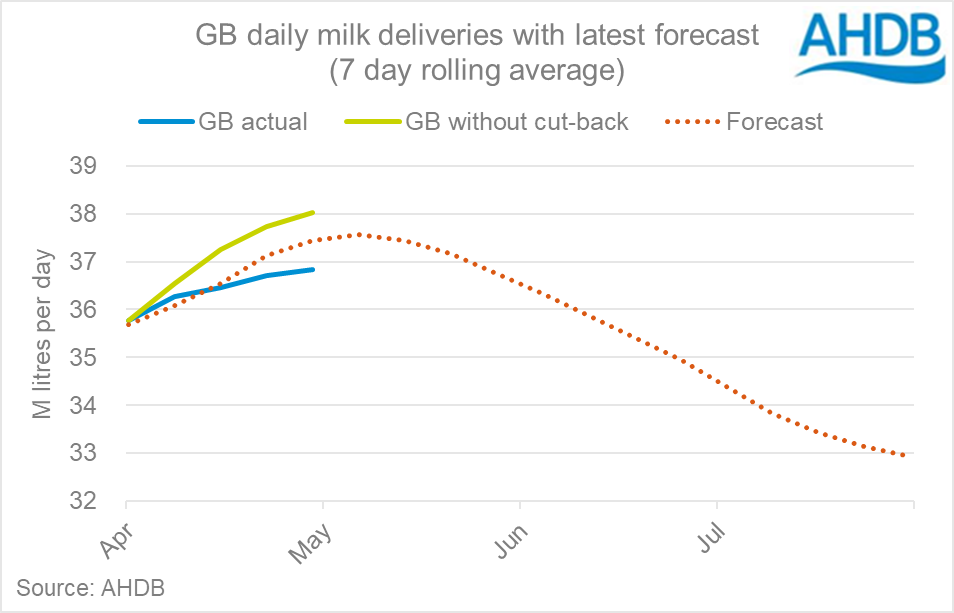Farmers cut 23 million litres from production in April
Monday, 11 May 2020
By Chris Gooderham
GB daily milk deliveries for the week ending 2 May averaged 36.84 million litres per day, up 0.4% on the previous week. There has been a re-weighting of the overall volumes now that we have passed the end of April, and this has lifted weekly numbers slightly. Despite that adjustment, milk production has continued its recent trend of rising very slowly through April. Production is now put at 1.6% below the forecast and 2.0% below last year. This gives an early April estimate for GB at 1,094m litres.
The 7-day rolling average has remained relatively flat at 36.84m litres per day for the last 6 days (27 April to 2 May), giving an early indication that we may have reached peak for the year. If this is the case, it will be the pull back by some farmers that has helped keep milk volumes down.
Milk production from those who have been asked to curb volumes by their milk buyers, continues to have an impact. Without that curbing of production, we estimate* April volumes would have been nearly 23 million litres higher at 1,117m litres. That would have put production at 17 million litres above our March forecast – thanks to a significant improvement in weather and ground conditions over the last few weeks.

If volumes had reached 1,117m litres it would have put considerably more strain on the processing capability of the country and likely would have led to significantly higher volumes of milk needing disposal on farm. Thanks to the reaction of those farmers who have cut back on volumes, the disposal of milk has been kept relatively in-check so far. Whether we continue to have sufficient capacity over the remainder of the spring will now be determined by retail sales continuing to remain high and processors continuing to run at, or near, capacity without breakdown or serious levels of staff absenteeism.
While the actions of some farmers have given the industry some breathing space, there remains concern over the financial impact on them as a result of the cut-back.
* Based on milk production levels from those who were not asked to curb volumes.

Sign up to receive the latest information from AHDB.
While AHDB seeks to ensure that the information contained on this webpage is accurate at the time of publication, no warranty is given in respect of the information and data provided. You are responsible for how you use the information. To the maximum extent permitted by law, AHDB accepts no liability for loss, damage or injury howsoever caused or suffered (including that caused by negligence) directly or indirectly in relation to the information or data provided in this publication.
All intellectual property rights in the information and data on this webpage belong to or are licensed by AHDB. You are authorised to use such information for your internal business purposes only and you must not provide this information to any other third parties, including further publication of the information, or for commercial gain in any way whatsoever without the prior written permission of AHDB for each third party disclosure, publication or commercial arrangement. For more information, please see our Terms of Use and Privacy Notice or contact the Director of Corporate Affairs at info@ahdb.org.uk © Agriculture and Horticulture Development Board. All rights reserved.

